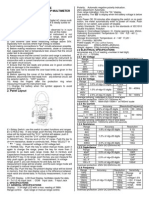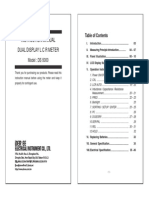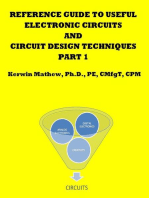A6013L Capacitor Meter Tester PDF
A6013L Capacitor Meter Tester PDF
Uploaded by
Carlos IrigoinCopyright:
Available Formats
A6013L Capacitor Meter Tester PDF
A6013L Capacitor Meter Tester PDF
Uploaded by
Carlos IrigoinOriginal Title
Copyright
Available Formats
Share this document
Did you find this document useful?
Is this content inappropriate?
Copyright:
Available Formats
A6013L Capacitor Meter Tester PDF
A6013L Capacitor Meter Tester PDF
Uploaded by
Carlos IrigoinCopyright:
Available Formats
A6013L
DIGITAL C METER OPERATION MANUAL
1. FEATURES
2. SPECIFICATIONS
2-1.GENERAL SPECIFICATIONS
Display
Easy and correct readout.
:LCD (Liquid Crystal Display) Max
Indication 1999.
High measuring accuracy.
LCD Backlight and data hold.
Measurements are possible even under a strong
Measurement:C (Capacitance)
magnetic field.
Range
:single 9 position, whole range value (from
LSI-circuit provides high reliability and durability.
0.1pF to 20000uF)
Input overload protection is provided.
Zero Adjustment :Manual (range:20pF)
LCD display for low power consumption and clear
Calibrate Adjustment :Have two internal adjustment. One
readout even in bright ambient light conditions.
is panel Zero adjustment.
In-line pushbuttons allow one hand operation.
Over-input :Display shows 1.
Light-weight and compact construction for easy
Sampling Time :3/second
operation.
Operating Temp :0 to 40.
Low battery condition is indicated on the LCD
Operating Humidity :80% MAX.R.H.
display.
Power Supply:Single, standard 9 volt battery. NEDA
1604IEC6F22
Battery Life :Alkaline type approx.: 200 hours.
2. Panel Layout
Zinc-Carbon type approx.: 100 hours
LCD Display: 3
Typical consumption current :3~4mA (200pF-200uF)
digits, character
Standard Accessories: Test alligator clips (red &
black)1 pair.
15mm high
Instruction manual...1 pc.
Back Light Button
Switch: Press this
button to switch on
back light if the dark
2-2. ELECTRICAL SPECIFICATION
Accuracy is (percentage of reading + number of digit)
circumstance light
at 235,<80%RH.
makes the reading
Range
200pF
2nF
20nF
200nF
2uF
20uF
200uF
2000uF
20mF
difficulty when measuring, the light will be
automatically turned off in 5 seconds. Press again to
switch it on again. If the battery is in weak power, the
light will be dimmed.
Rotary Switch: use this switch to select ranges
Accuracy
(0.5%+1d)
(2.0%+2d)
(4.0%+10d)
Resolution
0.1pF
0.001nF
0.01nF
0.1nF
0.001uF
0.01uF
0.1uF
1uF
0.01mF
Test
Frequency
820Hz
82Hz
8.2Hz
Max
indication
199.9pF
1.999nF
19.99nF
199.9nF
1.999uF
19.99uF
199.9uF
1999uF
19.99mF
COMInput Jack
+ Input Jack
Data-hold Switch (HOLD)
Zero ADJ.
pF= Pico Farad(10-12F )nF= nan Farad(10-9F). uF=
micro Farad(10-6F)
Zero Error: 20pF
Excitative voltage: Max.2.8Vrms
Overload Rating: Protection by a 0.2A/250V fuse.
instrument).
3.CONSIDERATION OF MEASUREMENT
(1) This C METER is intended for measuring the
(c) Very
low
capacitance
measurement
should
be
capacitance value of a capacitor. It is not intended for
performed by using extremely short leads in order to
determining
avoid introducing any stray inductance.
the Q factor for above reactive
components. Misleading readings may be obtained if the
(d) When using the optioned test leads, remember that the
measurement of capacitance of a resistor is attempted.
leads introduce a measurable capacitance to the
(2) When measuring components within circuit that circuit
measurement. As a first approximation, the test
must be switched
off
and
de-energized
before
connecting the test leads.
(3) Do not close (black & red) test leads.
(4) Instruments used in dusty environments should be
stripped and cleaned periodically.
(5) Do not leave the instrument exposed to direct heat from
the sun for long periods.
(6) Before removing the battery and fuse compartment
cover, ensure that the instrument is disconnected with
any circuit and the power switch is in the off position.
(7) For all measurements, should connect BLACK test lead
capacitance is measured by opening the leads at the
trips, recording the open circuit value and subtracting
that value.
(e) Capacitors, especially electrolytic, often have
notoriously wide tolerances. Do not be surprised if the
measured value is greater than the value marked on the
capacitor, unless it is a close tolerance type. However,
value is seldom drastically below the rated value.
(f) If changing range, measured value will be changed,
leakage-voltage capacitors will be checked also.
Leakage-resistance will be decreased in lower range.
into - terminal and RED test lead into + terminal.
4.CAPACITANCE(C) MEASURING PROCEDURE
(1) Select the range switch for the maximum expected
capacitance.
(2) Check "0" indication: If test range is 200pF, 2nF, 20nF,
should check "0" indication before test.
(3) Observe polarity when connecting polarized capacitors.
(4) Full discharge any capacitors.
(5) Connect the alligator clips to the capacitors leads.
(6) Read the display. The value is direct reading in the
electrical unit (pF, nF, uF) indicated at the selected
range switch. If display show 1, It indicate on
Out-of-Range measurement. If the display indicates one
or more leading zeros, shift to the next lower range scale
to improve the resolution of the measurement.
NOTE:
(a) If the capacitance value is unmarked, start from the
200pF range and keep increasing until the over-range
indication goes off and a reading is obtained.
(b) A shorted capacitor will read over-range on all ranges.
A capacitance with low voltage leakage will read over
range, or a much higher value than normal.
An open capacitor will read zero on all ranges (possibly
a few pF on 200pF range, due to stray capacitance of the
5. MAINTENANCE
1) 9-Volt battery replacement
a. Ensure the instrument is not connected to any external
circuit. Set the selector switch to
OFF position and remove the test leads from terminals.
b. Remove the screw on the bottom case and lift the
bottom case.
c. Remove the spent battery and replace it with a battery
of the same type.
2) Fuse replacement
a. Ensure the instrument is not connected to any external
circuit. Set the selector switch to
OFF position and remove the test leads from terminals.
b. Remove the screw on the bottom case and lift the
bottom case.
c. Replace the fuse with the same type and rating:
5X20mm, 200mA/250V, fast-blow fuse or as the
replacements.
You might also like
- Digital Multimeter DT830 Series ManualDocument12 pagesDigital Multimeter DT830 Series ManualJohn G.75% (4)
- Vc9808+ ManualDocument3 pagesVc9808+ ManualJose Dario Soto ParisNo ratings yet
- DassdafDocument15 pagesDassdafEdmar Bataque100% (1)
- Chapter 5 Octave Solutions ManualDocument34 pagesChapter 5 Octave Solutions Manualniquee9ner100% (3)
- AP2 Practice Exam #2 Answer KeyDocument11 pagesAP2 Practice Exam #2 Answer Keyabbas kazmiNo ratings yet
- Atom-Photon Interactions: Basic Processes and ApplicationsDocument16 pagesAtom-Photon Interactions: Basic Processes and ApplicationsJack LiuNo ratings yet
- A6013L Capacitor Meter TesterDocument2 pagesA6013L Capacitor Meter Testerhyu2123No ratings yet
- Manual de Uso Mastech Mas838Document11 pagesManual de Uso Mastech Mas838Mario Carrasco DiazNo ratings yet
- Digital Capacimeter Minipa MC-152-operation ManualDocument5 pagesDigital Capacimeter Minipa MC-152-operation Manualjorge_pinzon_70No ratings yet
- Operating Instructions Series Mm10 Digital Multimeter: Safety InformationDocument2 pagesOperating Instructions Series Mm10 Digital Multimeter: Safety InformationJuana Fernandez GonzalezNo ratings yet
- BK Precision 875B ManualDocument37 pagesBK Precision 875B ManualMiguel A JimenezNo ratings yet
- Manual IDEAL Series 700Document17 pagesManual IDEAL Series 700Enrique Matus RecabalNo ratings yet
- Ut33a Palm Size Multimeter ManualDocument13 pagesUt33a Palm Size Multimeter ManualTheo SopranoNo ratings yet
- MAS345Document31 pagesMAS345Abrahan CortezNo ratings yet
- Manual Multimetro Mastech My-67Document16 pagesManual Multimetro Mastech My-67WisdomBriceñoAbreuNo ratings yet
- 700 Series: 200 Amp Clamp MetersDocument12 pages700 Series: 200 Amp Clamp MetersTom BeanNo ratings yet
- Autoranging Digital Clamp Meter: MODEL: DT3150Document10 pagesAutoranging Digital Clamp Meter: MODEL: DT3150square17.gopiNo ratings yet
- MANUAL UTILIZATE TESTER Model 382252 PDFDocument7 pagesMANUAL UTILIZATE TESTER Model 382252 PDFSuru PanaiteNo ratings yet
- Component TesterDocument25 pagesComponent TestermajoNo ratings yet
- Manual Multimetro HPDocument2 pagesManual Multimetro HPMauricioNo ratings yet
- m830b 600v Hys004369Document8 pagesm830b 600v Hys004369ursuletzu72No ratings yet
- dso-tc3-digital-multimeter-manualDocument15 pagesdso-tc3-digital-multimeter-manualelvisNo ratings yet
- Mul 015Document12 pagesMul 015api-3730132No ratings yet
- Operator'S Instruction Manual: 903-150NAS 903-150NBS 303-150NCS 903-150NDSDocument20 pagesOperator'S Instruction Manual: 903-150NAS 903-150NBS 303-150NCS 903-150NDSPhạm VinhNo ratings yet
- Ut89x Digital Multimeter ManualDocument28 pagesUt89x Digital Multimeter ManualTabare MarzolNo ratings yet
- Multifunctional Digital Multimeter: User Manual Gebruikershandleiding Manuel D'UtilisationDocument9 pagesMultifunctional Digital Multimeter: User Manual Gebruikershandleiding Manuel D'UtilisationtonielhageNo ratings yet
- DCVG Holiday DetectorDocument20 pagesDCVG Holiday DetectorAgus EskenaziNo ratings yet
- Manual Multimeter Uni-T UT890DDocument5 pagesManual Multimeter Uni-T UT890DConsumerNo ratings yet
- Manual Equipo Gd6000aDocument21 pagesManual Equipo Gd6000aGiovanni TorresNo ratings yet
- Operation ManualDocument5 pagesOperation ManualNiksanetNo ratings yet
- Ac/Dc Clamp Meter: User 'S ManualDocument20 pagesAc/Dc Clamp Meter: User 'S ManualMartin OngNo ratings yet
- Vc97 User ManualDocument8 pagesVc97 User ManualWilliam ConejoNo ratings yet
- DS Standard-CLC E 11663Document6 pagesDS Standard-CLC E 11663Pooya MirzabeygiNo ratings yet
- MS8211-ManualDocument12 pagesMS8211-ManualАнатолий РябухаNo ratings yet
- Procedure Power Capacitor TestDocument4 pagesProcedure Power Capacitor TestKhanNo ratings yet
- User's Manual For VC99+ 3 6/7 DMM 1.summary This AIDETEK VC99+ Multimeter Is A SteadyDocument5 pagesUser's Manual For VC99+ 3 6/7 DMM 1.summary This AIDETEK VC99+ Multimeter Is A SteadyNick NormanNo ratings yet
- Manual Telurómetro VICTOR 4105ADocument24 pagesManual Telurómetro VICTOR 4105AAnonymous e4QN1i100% (1)
- 33XR ManualDocument20 pages33XR ManualAbubacker SiddiqNo ratings yet
- 33XRA Manual Multimetro AmproDocument73 pages33XRA Manual Multimetro Amprometrologo78No ratings yet
- PM51ADocument70 pagesPM51ATateszNo ratings yet
- TTi Model QPX1200 DC Power Supply Service ManualDocument49 pagesTTi Model QPX1200 DC Power Supply Service ManualT3brzNo ratings yet
- DER EE DE-5000 English User ManualDocument19 pagesDER EE DE-5000 English User ManualRenatoBašić100% (2)
- Megabras Mtd20kweDocument44 pagesMegabras Mtd20kweEric BalabarcaNo ratings yet
- MS2108A English ManualDocument24 pagesMS2108A English ManualiconeykregNo ratings yet
- Model 950Document10 pagesModel 950ArnoNo ratings yet
- General Radio 1650-BDocument60 pagesGeneral Radio 1650-BkrendelaNo ratings yet
- Model 380580 Battery Powered Milliohm Meter: User's GuideDocument8 pagesModel 380580 Battery Powered Milliohm Meter: User's GuideAdam SonenshineNo ratings yet
- Operation ManualDocument6 pagesOperation ManualChristian SchwartzNo ratings yet
- Phenix 4120-10 2.3Document27 pagesPhenix 4120-10 2.3Trần Danh VũNo ratings yet
- DT-5300 ManualDocument20 pagesDT-5300 Manualleo_j9No ratings yet
- Em266 enDocument17 pagesEm266 enगणेश पराजुलीNo ratings yet
- Users Manual: MultimeterDocument20 pagesUsers Manual: MultimeterchepebotellaNo ratings yet
- Tentech MTD20KWe Digital Earth Tester Users Guide ManualDocument45 pagesTentech MTD20KWe Digital Earth Tester Users Guide ManualAnonymous voVeDickM100% (1)
- DT92xx MultimeterDocument5 pagesDT92xx Multimeterhammouche_soufianeNo ratings yet
- Tenma LCR Meter For Inductance, Capacitance and ResistanceDocument12 pagesTenma LCR Meter For Inductance, Capacitance and ResistanceIanNo ratings yet
- EM34-3 & EM34-3XL Operating Instructions: (For Model With Two Digital Meters)Document24 pagesEM34-3 & EM34-3XL Operating Instructions: (For Model With Two Digital Meters)Asigri Mahfouz JohnNo ratings yet
- Megger SDKY - IT811manualDocument4 pagesMegger SDKY - IT811manualKing MaxNo ratings yet
- Reference Guide To Useful Electronic Circuits And Circuit Design Techniques - Part 2From EverandReference Guide To Useful Electronic Circuits And Circuit Design Techniques - Part 2No ratings yet
- Analog Dialogue Volume 46, Number 1: Analog Dialogue, #5From EverandAnalog Dialogue Volume 46, Number 1: Analog Dialogue, #5Rating: 5 out of 5 stars5/5 (1)
- Design of Electrical Circuits using Engineering Software ToolsFrom EverandDesign of Electrical Circuits using Engineering Software ToolsNo ratings yet
- Reference Guide To Useful Electronic Circuits And Circuit Design Techniques - Part 1From EverandReference Guide To Useful Electronic Circuits And Circuit Design Techniques - Part 1Rating: 2.5 out of 5 stars2.5/5 (3)
- Instrumentation. of UvDocument4 pagesInstrumentation. of UvPriya VagelaNo ratings yet
- IB Physics A2 (Circular Motion)Document46 pagesIB Physics A2 (Circular Motion)Aditya SARMA (9CWA)No ratings yet
- Complex Numbers Additional Notes 1Document11 pagesComplex Numbers Additional Notes 1Jade GurtizaNo ratings yet
- OCR A Physics A Level: Topic 6.5: Medical ImagingDocument12 pagesOCR A Physics A Level: Topic 6.5: Medical Imagingsohaib389892No ratings yet
- Lect02 - Complex Functions and MappingDocument55 pagesLect02 - Complex Functions and MappingMuhamamd IdreesNo ratings yet
- Introduction To Electric Drives: Dr. K. R. RajagopalDocument68 pagesIntroduction To Electric Drives: Dr. K. R. RajagopalDevesh RaiNo ratings yet
- Mod RelayDocument1 pageMod RelaySkvkNo ratings yet
- Transformer Manufacturing Processes PDFDocument78 pagesTransformer Manufacturing Processes PDFErhan Karabaş67% (3)
- 2nd Validating Test PhysciDocument2 pages2nd Validating Test PhysciReign MayorNo ratings yet
- Heat and Mass Transfer QuizDocument7 pagesHeat and Mass Transfer Quizdsathiya0% (1)
- Chirped PulseDocument2 pagesChirped PulseKapila WijayaratneNo ratings yet
- CHM-101 Chapter 1Document23 pagesCHM-101 Chapter 1razan136No ratings yet
- Homogeneous CoordinatesDocument14 pagesHomogeneous CoordinatesAjad AliNo ratings yet
- Important Derivations of Physics, Class 12 - CBSE: R. K. Malik'S Newton Classes RanchiDocument11 pagesImportant Derivations of Physics, Class 12 - CBSE: R. K. Malik'S Newton Classes RanchiPadma kannaNo ratings yet
- Field Guide to Radiometry SPIE Press Field Guide FG23 Barbara Grant 2024 Scribd DownloadDocument70 pagesField Guide to Radiometry SPIE Press Field Guide FG23 Barbara Grant 2024 Scribd Downloadudanancye100% (3)
- German Problems 2009 PDFDocument131 pagesGerman Problems 2009 PDFchemtabNo ratings yet
- Potential Energy and Conservation of Energy: (Chapter 8)Document14 pagesPotential Energy and Conservation of Energy: (Chapter 8)Febrina RahayuNo ratings yet
- Chemical BondingDocument13 pagesChemical BondingSenpai JenjenNo ratings yet
- Paper 2 Nov 2003 PhysicsDocument20 pagesPaper 2 Nov 2003 PhysicssolarixeNo ratings yet
- From The Preface To The First EditionDocument4 pagesFrom The Preface To The First EditionluchogilmourNo ratings yet
- Unit-4 Transformer (Magnetic Circuit) - 1-4Document4 pagesUnit-4 Transformer (Magnetic Circuit) - 1-4rajsandeep2410No ratings yet
- Elliot Wave TheoryDocument47 pagesElliot Wave Theoryapi-3816484100% (19)
- Chains & RopesDocument8 pagesChains & RopesdarshanjasoliyaNo ratings yet
- 351expt 04 ModelsDocument17 pages351expt 04 ModelsFirst LastNo ratings yet
- 2016 Specimen Paper 4 Mark SchemeDocument6 pages2016 Specimen Paper 4 Mark SchemelolismNo ratings yet
- Journal of Medicinal Chemistry ArticleDocument63 pagesJournal of Medicinal Chemistry ArticleJudy UgwuegbuNo ratings yet
- Chemistry Olympiad SyllabusDocument3 pagesChemistry Olympiad Syllabusrizwan chowdhuryNo ratings yet

























































































